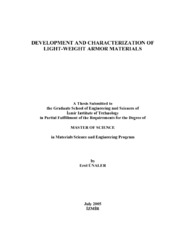Please use this identifier to cite or link to this item:
https://hdl.handle.net/11147/3318| Title: | Development and characterization of light-weight armor materials | Authors: | Ünaler, Erol | Advisors: | Tanoğlu, Metin | Keywords: | Ballistic impact Resin transfer molding |
Publisher: | Izmir Institute of Technology | Abstract: | In this study, E-glass/unsaturated polyester composite laminates using woven and non-crimp stitched fabrics and isophtalic and orthophthalic polyester resin were fabricated using RTM (Resin Transfer Molding) technique. In addition to composite laminates, multilayered sandwich laminates using aluminum (Al) plates and alumina (Al2O3) tiles were manufactured to improve the ballistic resistance of the composite structure. An experimental investigation was carried out to determine the mechanical and ballistic performance of E-glass/unsaturated polyester composite laminates with and without aluminum and alumina tiles. The mechanical properties of the composite laminates made with 0/90 woven fabrics and 0/90 and 0/-45/+45/90 non-crimp stitched fabrics and two resin systems were measured for comparison of fabric and resin types. The flexural strength and modulus, compressive strength and modulus through ply-lay up and in plane loading directions, mode I interlaminar fracture toughness and apparent interlaminar shear strength of the composites were measured to evaluate the effects of the fiber architecture on the mechanical properties of the composites. It was found that in general the mechanical properties of the composites made with 0/90 woven fabrics are higher than those of the composites made with multiaxial non-crimp stitched fabrics. Moreover, the composite plates with and without aluminum plates and alumina tiles were subjected to ballistic impact by AP (armor piercing), FSP (fragment simulating projectile) and ball (B) type projectiles with initial velocities in the range of 420-1173 m/s. The ballistic test results exhibit that the polymer composites have ballistic resistance against 7.62 mm fragment simulating projectiles (FSP) up to 1001 m/s projectile velocities. However, the composites without any support layer are not sufficient to stop AP projectiles. The sandwich panels containing ceramic tiles subjected to the ballistic impact by AP and FSP projectiles exhibited only partial penetrations at all the velocities applied within the study (446-1020 m/s with AP and 435-1173 m/s with FSP). The extensions of damages in the composites were evaluated after impact. It is concluded that the multilayered composite structures have capacity against the ballistic threats and potential to be used as lightweight armor materials. | Description: | Thesis(Master)--Izmir Institute of Technology, Materials Science and Engineering, Izmir, 2005 Text in English; Abstract: Turkish and English 70 leaves |
URI: | http://hdl.handle.net/11147/3318 |
| Appears in Collections: | Master Degree / Yüksek Lisans Tezleri |
Files in This Item:
| File | Description | Size | Format | |
|---|---|---|---|---|
| T000330.pdf | MasterThesis | 2.61 MB | Adobe PDF |  View/Open |
CORE Recommender
Page view(s)
300
checked on Nov 18, 2024
Download(s)
158
checked on Nov 18, 2024
Google ScholarTM
Check
Items in GCRIS Repository are protected by copyright, with all rights reserved, unless otherwise indicated.